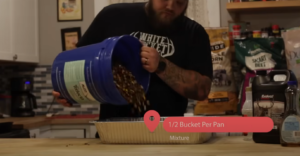Building your own deer and turkey feeder can be a rewarding project that enhances your wildlife management efforts. Start by selecting a suitable location, ideally in an area frequented by deer and turkeys, ensuring it’s easily accessible for maintenance. Gather materials such as wood, PVC pipe, or metal, depending on your design preferences. A simple and effective feeder can be made using a wooden box with slats for drainage and ventilation, which helps keep the feed dry.
Start With A Sturdy Base
 Construct the feeder by creating a sturdy base and sides, then attach a sloped roof to prevent rain from entering. For added functionality, you can create a funnel system using PVC pipe, allowing for easy dispensing of feed while minimizing waste. You can also use different types of jic fittings. don’t worry if you are wondering what does jic mean, so were we. Long story short, they are a special type of fitting. Be sure to raise the feeder off the ground to deter pests and prevent spoilage; using legs or a platform works well for this.
Construct the feeder by creating a sturdy base and sides, then attach a sloped roof to prevent rain from entering. For added functionality, you can create a funnel system using PVC pipe, allowing for easy dispensing of feed while minimizing waste. You can also use different types of jic fittings. don’t worry if you are wondering what does jic mean, so were we. Long story short, they are a special type of fitting. Be sure to raise the feeder off the ground to deter pests and prevent spoilage; using legs or a platform works well for this.
Once assembled, fill the feeder with high-quality grains or seeds that attract both deer and turkeys, such as corn, wheat, or special blends designed for wildlife. Regularly check the feeder to replenish the feed and monitor for any damage, ensuring it remains a reliable food source. With your DIY feeder in place, you’ll not only support local wildlife but also enjoy the rewarding experience of observing these animals up close.
Homemade Vs Store-Bought
When deciding between a DIY and a store-bought deer feeder, it’s essential to weigh the pros and cons of each option. DIY feeders offer a unique opportunity for customization, allowing you to tailor the design and functionality to meet your specific needs and the local wildlife patterns. By selecting materials and sizes that suit your environment, you can create a feeder that not only fits your budget but also integrates seamlessly into your landscape. Furthermore, building your own feeder can be a fulfilling project, offering a sense of accomplishment and the chance to engage with nature in a hands-on way.
 On the other hand, store-bought feeders provide convenience and often come with features designed for durability and efficiency. Many commercial options are engineered to withstand various weather conditions and are built with advanced dispensing mechanisms that minimize waste and keep feed dry. Purchasing a feeder can save time and effort, making it an attractive choice for those who may not have the tools or skills to construct their own.
On the other hand, store-bought feeders provide convenience and often come with features designed for durability and efficiency. Many commercial options are engineered to withstand various weather conditions and are built with advanced dispensing mechanisms that minimize waste and keep feed dry. Purchasing a feeder can save time and effort, making it an attractive choice for those who may not have the tools or skills to construct their own.
Ultimately, the decision between DIY and store-bought depends on your personal preferences, budget, and commitment to wildlife management. Whether you choose to build your own feeder or invest in a pre-made option, both approaches can effectively attract deer and enhance your outdoor experience.